Your cart is currently empty!

Choosing a Wood Shaper

A wood shaper is a machine that is used for cutting or shaping wood into different shapes, and it comes in many different models. When choosing a shaper, you need to consider factors like speed, safety and reversibility. In addition to this, you also want to make sure you buy a model that is made for the type of wood you plan to work with.
High-speed vertical shaper
High-speed vertical wood shapers are a type of woodworking machine that combines the speed of a router with the accuracy and precision of a shaping machine. They cut and mould wood to any shape or profile you desire.
There are many varieties of shapers on the market today. They range from freestanding models to benchtop machines. All of them perform the same basic tasks.
Freestanding models have larger tables and more power. Benchtop shapers are more economical and do not require as much space.
The shaper has a vertical spindle that drives the cutter head. This allows the operator to shape and edge a workpiece with ease. Most cutter heads are made from steel, aluminum or carbide.
Aside from the spindle, the wood shaper comes with a worktable and a fence. These fixtures help the user set up and use the tool.
Some shapers have power feeders, which reduce the need for sanding. Power feeders also give the operator more control over climbing cuts.
Reversible shaper
If you’re considering buying a wood shaper, you might want to consider a reversible model. Not only will it add convenience, it may also save you time. This type of shaper allows you to feed the workpiece through on one side and then reverse the process to cut the lumber in a different direction.
Wood shapers have some advantages over routers, such as higher horsepower, less vibration, and more versatility. However, these tools are not always the most cost-effective option. They are more expensive, and can be difficult to use. You’ll also have to pay close attention to the way you present your work to the machine.
In the old days, running a shaper backwards was a no-no. The risk of your nut spinning off was high. Fortunately, modern practices have dramatically reduced this risk.
Most reversible shapers use a “pinned” washer to prevent the nut from slipping and loosening. Reversible shapers are usually installed at the factory.
Spindle on the side
A shaper is a machine used for shaping and cutting wood. It uses a rotating spindle and cutter head to cut curved surfaces. They are generally more powerful than routers. These machines are useful for precise work. But they can be dangerous when used incorrectly.
Shapers come in different shapes and sizes. The most common types are benchtop and freestanding. Freestanding models have larger tables and more power. This makes them ideal for high-speed work.
Shapers can also be adjusted to perform specialized cuts. Some accessories include sliding tables, tenoning hoods, and tilting arbors. You can even mount multiple cutter heads to the spindle.
When using a shaper, you need to take care when you place the workpieces into the machine. If they are not presented to the spindle in the correct direction, they could slip out of the machine like a missile.
Shaper cutters should be protected by a plastic guard. You can also put holddowns on the spindle to help keep your hands from getting caught in the cutter.
Safety precautions
When working with a wood shaper, safety precautions must be taken. A wood shaper is a tool used to cut, shape and mould the edges of stock.
It uses a spindle driven by a motor that rotates a cutter head at speeds between seven thousand to ten thousand RPM. The most common type of shapers use a vertical spindle. Cutter heads are generally made of aluminum or steel. There are also specialized models that can be used for different tasks.
For the safest operation, the cutter must be very sharp. Most cutters are made from high speed steel or carbide. Wearing protective glasses and a mask is important.
Never force a cut. If you need to make a deep cut, try taking a few partial cuts first. Be careful with figured grain. Also, do not stand in front of the machine.
Make sure that the fence is secure. If you are using a panel cutter, ensure that the workpiece is held tightly on the table. In addition, you must use a feather board to guide the workpiece.
by
Tags: